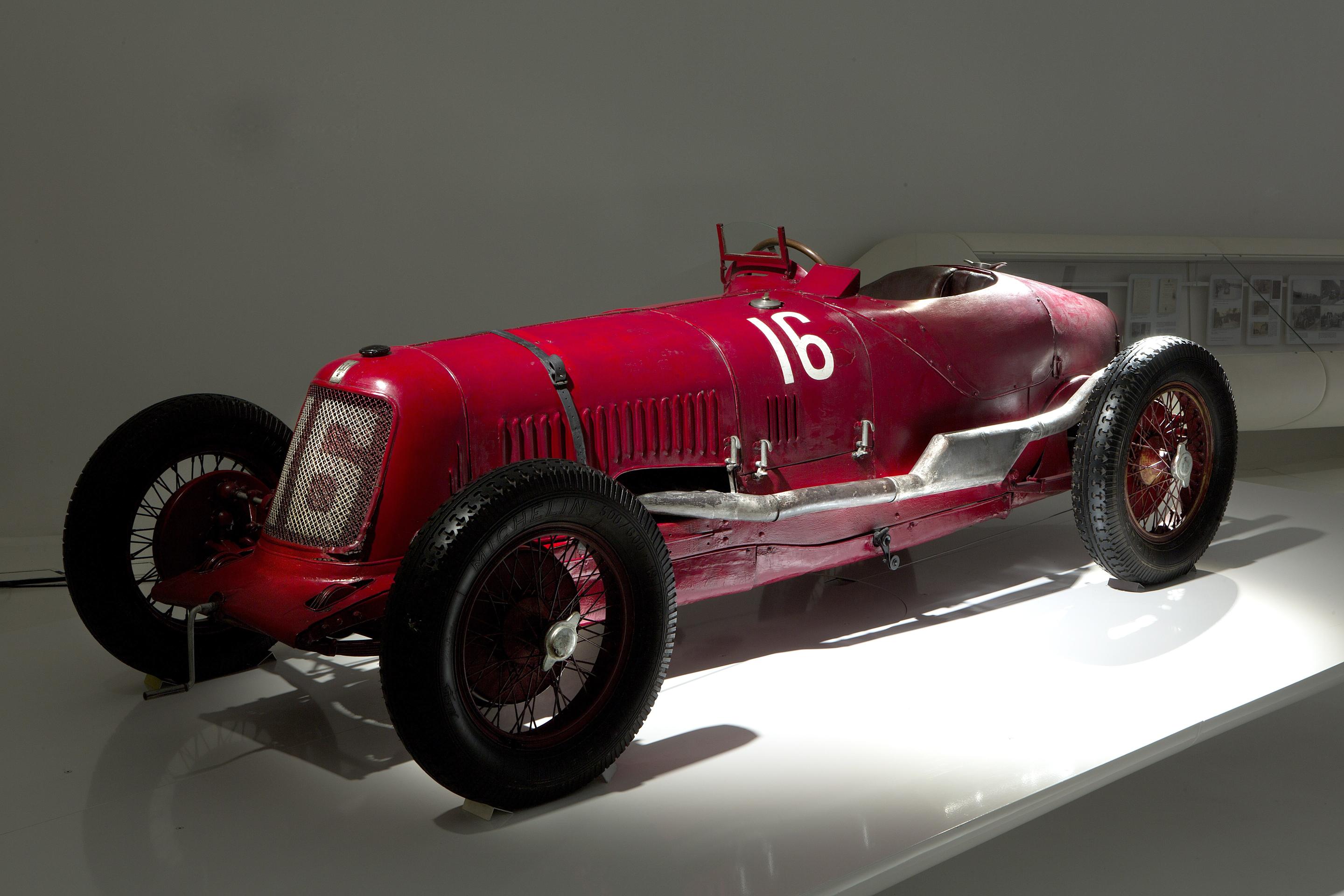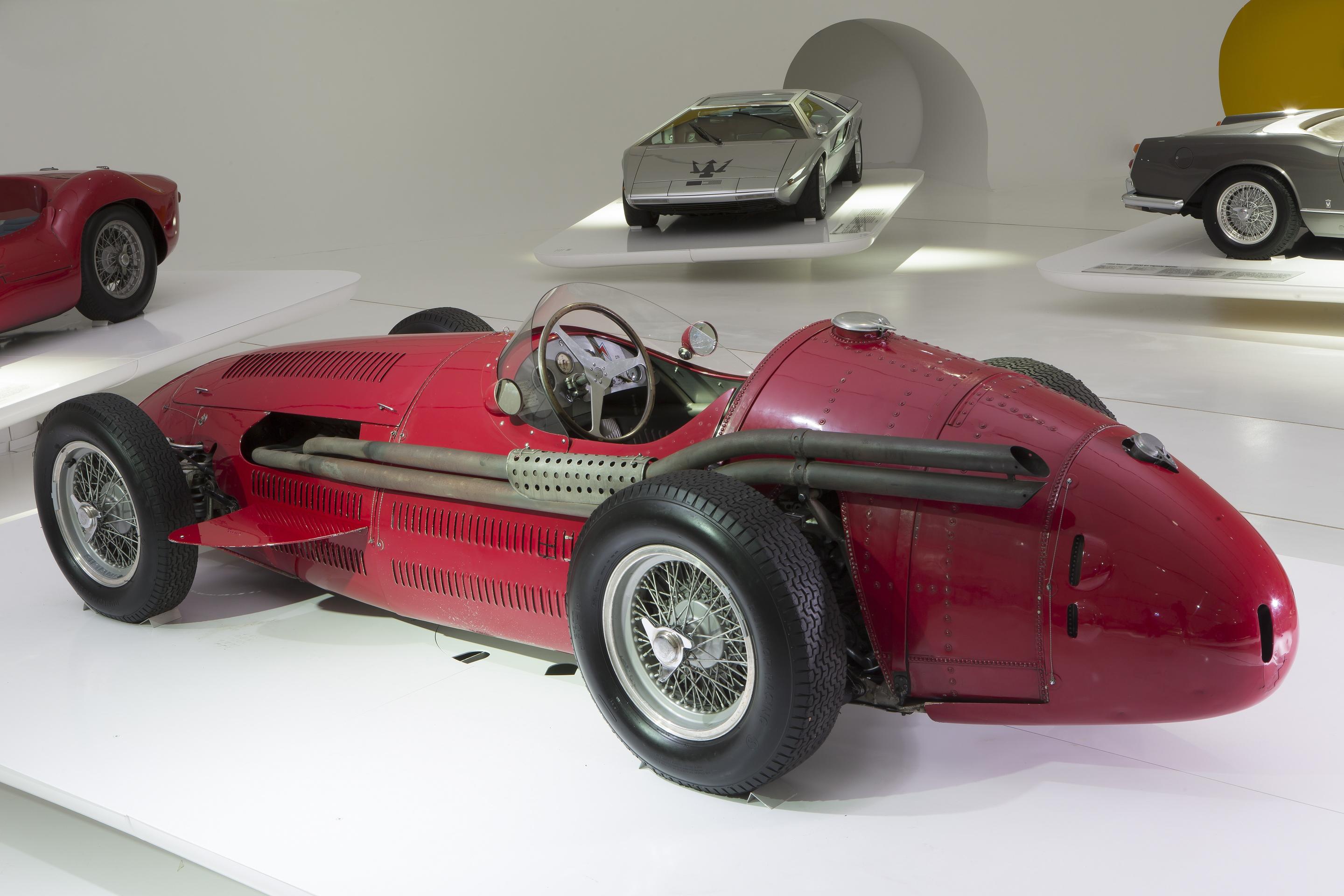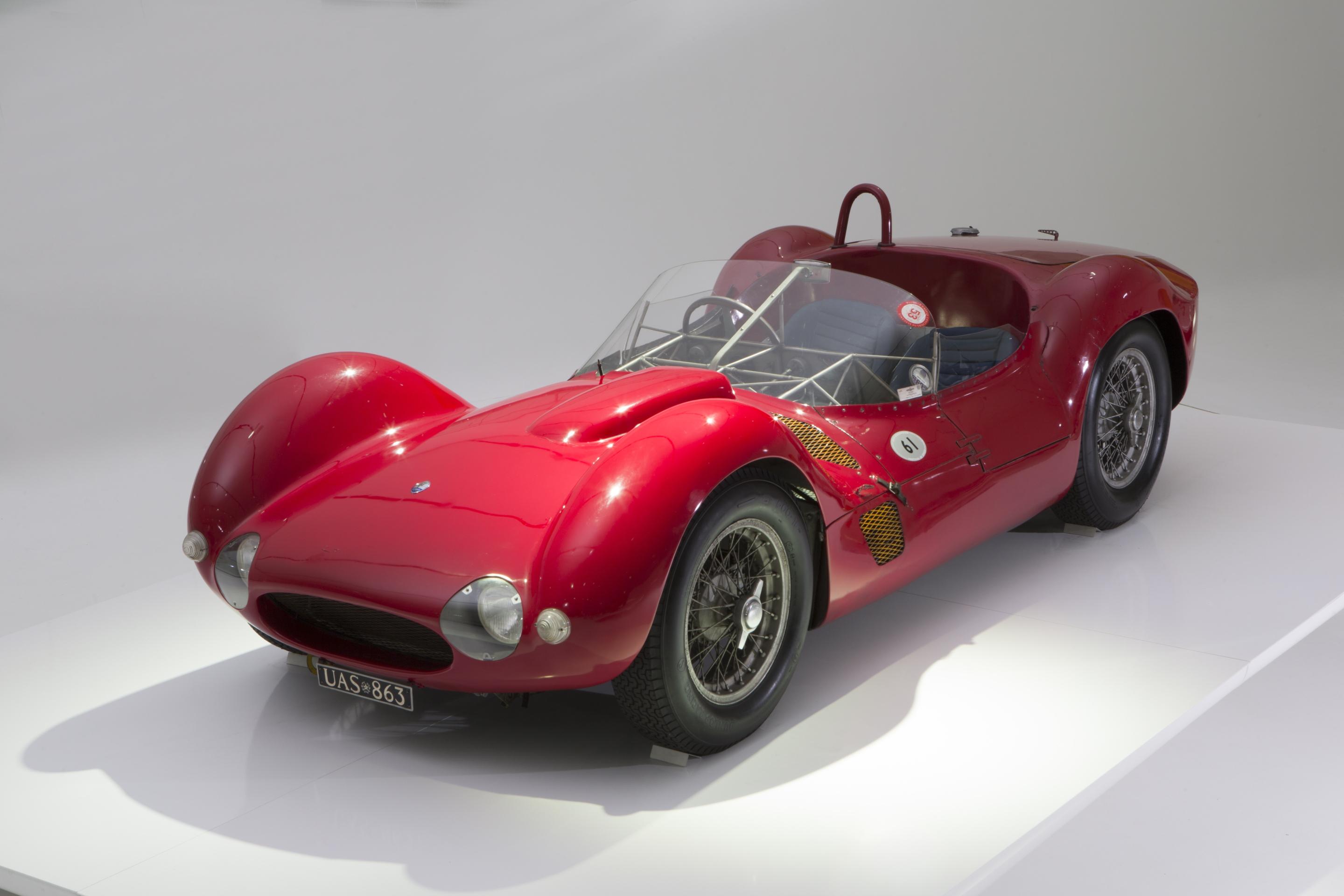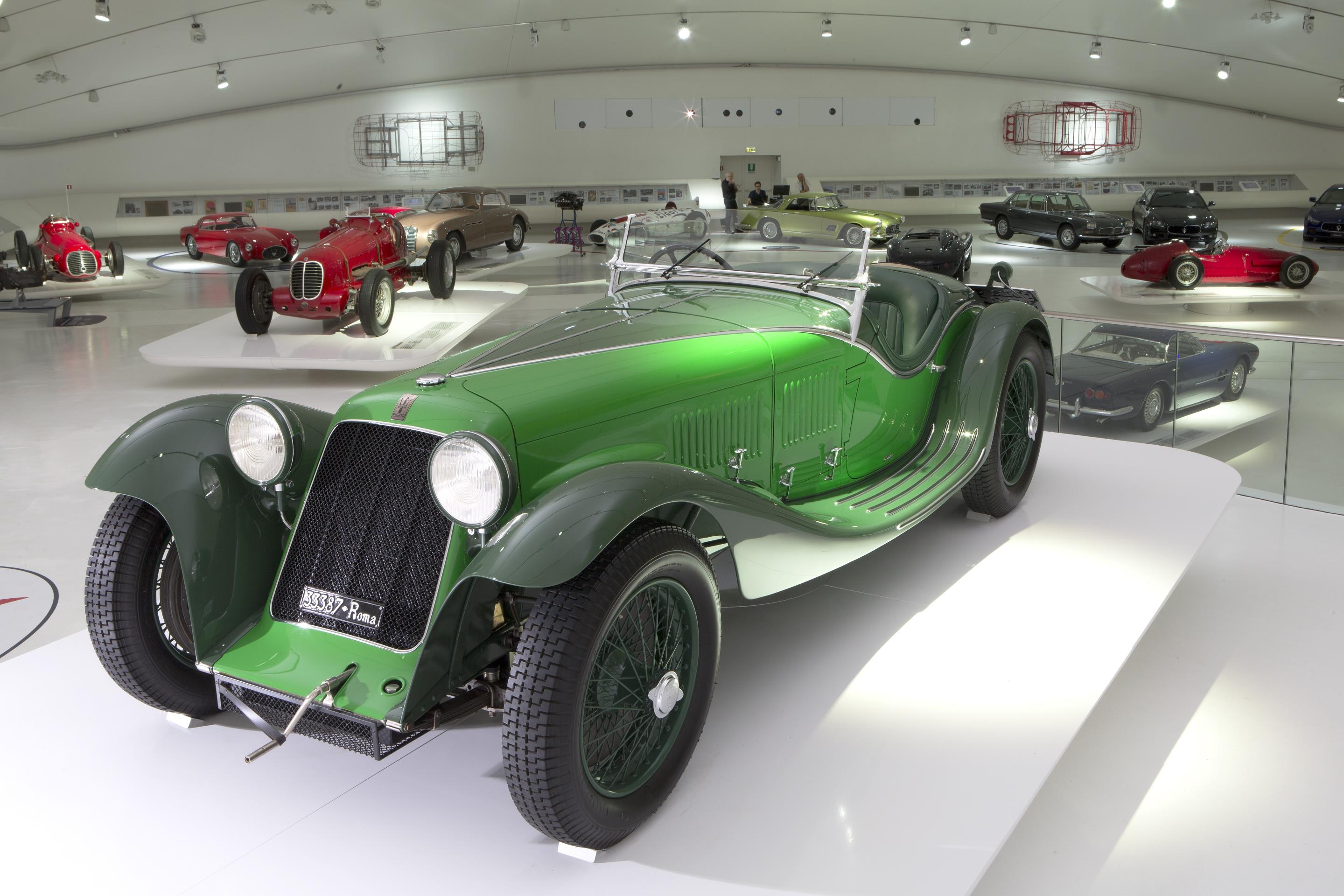
New exhibition retraces a century of Maserati at the spectacular Enzo Ferrari Museum (MEF). The unique exhibition hosts a priceless collection of historic models and gives visitors the opportunity to relive the history of Maserati through technology that transports you to the heart of the event.
Thursday, 19th June 2014 – A unique exhibition dedicated to the Centennial of Maserati was inaugurated in Modena this morning. MASERATI 100 – A Century of Pure Italian Luxury Sports Cars retraces the story of the Italian car manufacturer through an exhibition featuring some of the Trident marque’s most significant road and racing cars, plus a highly engaging show employing 19 projectors, enabling visitors to relive the most significant moments in the history of Maserati and to learn about the individuals who shaped its history. Staged in the futuristic Enzo Ferrari Museum, a stone’s throw from the Maserati headquarters in Viale Ciro Menotti, the exhibition will run until January 2015. Considering the historic value of the models exhibited, this is the greatest exhibition of Maserati cars ever staged anywhere in the world.
The inauguration of the new exhibition was attended by the CEO of Maserati, Harald Wester, and the Chairman of Ferrari, Luca Cordero di Montezemolo. They were joined by the cousins Carlo and Alfieri Maserati, sons, respectively, of Ettore and Ernesto Maserati, the two brothers who in 1914, together with Alfieri Maserati, founded the company that still bears their name today. The guest of honour at the inauguration was the legendary Sir Stirling Moss, the 1950s Maserati racing driver who scooped incredible victories for the Trident marque. The curator of the exhibition is Adolfo Orsi jr., grandson and son of Adolfo and Omer Orsi, owners of Maserati between 1937 and 1967. Coordinating the exhibition on the Maserati side is Luca Dal Monte, the company’s director of public relations and press. The exhibition is organised under the supervision and direction of Antonio Ghini, director of MEF and of the Ferrari Museum in Maranello.
Twenty-one Maseratis will be on permanent display for the duration of the exhibition and a total of approximately 30 will be admired over the course of the six-month run. Ten or so cars will be exhibited on a rotation basis, allowing them to take part in the countless events being staged across the globe to mark the Maserati centenary in the coming months. In keeping with the exhibition venue, which is dedicated to Enzo Ferrari as it was the birthplace of the legendary Modena-born car manufacturer, visitors will also have the opportunity to see rare Ferrari models and the most important Alfa Romeo racing cars of the pre-war period which were driven by Ferrari or entered in international competitions by the racing stable that still bears his name today. This part of the exhibition is located in the large workshop, where Enzo’s father worked from the end of the 19th Century until his death, which today houses the extension to the Museum’s exhibition space.
At the exhibition inauguration, the CEO of Maserati Harald Wester observed that: “The Centennial of Maserati could not have come at a better moment in our history. I say this because today Maserati is a thriving company, with new models that have proven hugely popular with an ever-increasing audience and others, in the pipeline, which will propel the company towards the prestigious goals that we have set. This exhibition, which retraces our first century of history, is truly one of a kind: never before have all these models which have shaped our history been gathered together under one roof.”
The Chairman of Ferrari, Luca di Montezemolo, who played a critical role in the re-launch of Maserati 15 years ago, said: “Today has a two-fold significance for me: I can clearly recall the conditions of quasi-neglect in which Maserati was floundering in 1997 when, together with my team at Maranello, I took up the challenge of re-launching the company. We shut the production sheds for six months, renovating and re-industrialising them, we created the new executive building and the large, spectacular showroom and, above all, we began working on the design and production of new models, one of which in particular has come to embody the current success: the 2003 Quattroporte. After this success story, Ferrari is today managing this important Museum which helps demonstrate to the entire world the unique ability that Italian car manufacturers have always had to build cars that are truly the stuff of dreams.”
The choice of which cars to exhibit fell to the exhibition curator, Adolfo Orsi, who explained his selection criteria: “In the difficult choice between the countless models, both racing and road-going, that have shaped the long history of Maserati, I tried to imagine “the dream-garage” of every car enthusiast, selecting not only the best in terms of engineering and style, but also the most important and historically significant examples of each model. I was fortunate to find an amazing spirit of collaboration on the part of dedicated collectors, who very generously agreed to lend their vehicles, some of which have been flown here from the other side of the Atlantic as they are virtually impossible to find in Europe.” It is therefore safe to say that MASERATI 100 will be the most important selection of Maserati cars ever presented.
The common denominator of the cars on show is an inimitable style which is profoundly… Maserati. Lorenzo Ramaciotti, current head of the FCA Style Centre as well as Maserati, and the inspiration behind the latest Maserati projects, underlined the originality and creativity of the stylistic journey undertaken by the Trident marque, which is apparent in the models exhibited: “For exclusive cars like Maseratis, style, together with speed and power, has always been a key element of success. Maserati’s use of Italian designers who enjoyed the utmost freedom means that now, through the models on display, we can read a veritable anthology of designers at the height of their creative prowess. From Pininfarina, Touring and Frua to Bertone, Ghia, Giugiaro, Vignale and Zagato, all have contributed to the aesthetic heritage of Maserati with memorable models. Today the Maserati Style Centre is proud to carry on the tradition of the finest Italian Style with great passion, well aware of the responsibility that comes with a century of glorious history.”
The Maserati exhibition encapsulates the two spirits of the company: the initial “sports” vocation that characterised the period from the early 1920s until the end of the 1950s, followed by a shift in focus to road-going models, a period that testified to the company’s coming-of-age as a car manufacturer.
Among the highlights of the exhibition are cars like the Tipo 26, the first car to sport the Maserati marque; and the V4 Sport Zagato, which set the world speed record in 1929 driven by Baconin Borzacchini. It was re-bodied in 1934 by Zagato and is a recent winner at the Concorso d’Eleganza at Villa d’Este. The exhibition would not have been complete, of course, without the legendary Maserati 250 F – winner of the Formula 1 World Championship with Juan Manuel Fangio in 1954 and in 1957, the year when the Argentine ace triumphed after a fantastic comeback in the epic German Grand Prix at the Nürburgring circuit. A phenomenal Formula One that helped build the legendary reputation Maserati enjoyed in the 1950s.
Stirling Moss, who attended the inauguration, drove this particular racing car to some of his greatest ever victories, for example in the Italian and Monaco Grand Prix races of 1956. And of course it would be unforgivable not to mention the Tipo 60 “Birdcage”, another of the cars driven by Moss. This famous two-seater sports racing car with front-mounted engine, an ingenious Italian response to ever-evolving chassis for racing cars, was produced by welding together dozens of slender metal tubes to guarantee a rigid yet lightweight chassis. Used on the track by a number of private racing teams, it brought fame and prestige to Maserati with numerous wins from 1959.
The road cars on show include one model which, although produced only in limited numbers and still in a rather artisan manner, constituted Maserati’s first road car: the A6 1500 of 1947 bodied by Pinin Farina and built around a racing engine. This was a first attempt, a sort of general rehearsal, which hinted at the future of the Modena company. Taking a chronological leap forward, we find the 3500 GT of 1957: the first granturismo. This was the forerunner to other important Maserati coupé and spider models destined to earn a place in the automobile history books. And then there is the first series of the “world’s fastest saloon,” the Quattroporte of 1965 once owned by Italian actor and Federico Fellini favourite Marcello Mastroianni.



Antonio Ghini, Director of the Museum named after Enzo Ferrari, said: “The presence of an exhibition celebrating 100 years of Maserati in the Museum dedicated to Enzo Ferrari should come as no surprise. In reality, had Maserati not existed, Ferrari would not have been spurred on by the pressure of a rival, so this competition helped make Ferrari the universally acknowledged success story it is today. Indeed, Maserati was around even when Enzo Ferrari was a racing driver and, in the 1930s, it was an arch rival when Ferrari, with his motor racing team, competed with Alfa Romeo cars. Ferrari was well acquainted with the engineering talent of the Bologna-born brothers who had chosen the Trident as the symbol for their racing cars. However, what really sparked the future rivalry between the companies was the relocation of Bologna-based Maserati to Modena, following its takeover by the Orsi family. Future rivalry, because while Maserati in 1939 and 1940 won the world’s most celebrated race, the Indianapolis 500, Ferrari was still busy building his first car, the 815 that didn’t even sport his name. Only in the post-war period did the Trident and the Prancing Horse cross swords, and often drivers too, with Fangio crowned Formula 1 World Champion for both Ferrari and Maserati. The rivalry continued on the road, with the magnificent granturismo models designed and built just a few kilometers apart: in Modena and in Maranello. This exciting challenge, which made Modena and Italy the global reference for motorsport, came to a halt in the 1960s: while Ferrari remained firmly in the hands of its founder, who also gained backing from the powerful Fiat Group, Maserati underwent a series of changes in ownership, abandoning the world of competitive racing and adopting a different strategy in terms of market positioning. The “Renaissance” of the precious Trident marque came about in the 1990s with the acquisition of Maserati by Fiat Group and its carefully planned relaunch, entrusted precisely to its long-time rival, Ferrari. The launch of the Quattroporte in 2003 heralded the new take-off of this remarkable brand which today celebrates 100 years in business, presenting in this unique exhibition some of the most important and significant examples of its work.”
The inauguration was also attended by Carlo Maserati, son of Ettore, who worked alongside Alfieri in 1914. He remarked: “100 years have passed since uncle Alfieri founded the company ‘Società anonima Officine Alfieri Maserati’ and 116 since 1898 when the eldest brother, Carlo, then just 17, produced a motorised bicycle fitted with an engine he had designed and built by himself at home; it was an achievement that sparked a passion in his brothers, prompting them to follow his lead. The technical and sporting success they notched up in almost 70 consecutive years of business with both the Trident marque and that of OSCA is well known. This longevity can be attributed to harmonious relations within the family and a technical prowess that enabled them to produce a racing car in just six months of work. In memory of my father Ettore and my other uncles Bindo, Ernesto and Mario, I would like to express my gratitude to all those who have enabled Maserati to live on and to strive towards new goals.”
Alfieri Maserati, son of Ernesto, remembered that: “Founded as Officine Alfieri Maserati in 1914, this company, which sprang from the enterprising spirit and genius of its founder, my uncle Alfieri, kept on going after his untimely death in March 1932, thanks to the determination and great personal sacrifice of his brothers. I’m duty-bound also to mention the outstanding design and engineering skills of the youngest of the brothers, Ernesto Maserati, my father. In those days the brothers produced a series of formidable racing cars, both Grand Prix models and “Voiturettes”, as well as record-breaking automobiles that held up to 13 international speed records at the same time. After the Maserati brothers left the company in 1947, others carried on their work successfully. The acquisition by Fiat Group has enabled Maserati to attain the dominant position it enjoys today, with growing development in terms of quality and sales. The Centenary happily falls in the midst of all this, and the hard work, commitment and enthusiasm of all those who work at Maserati, a hundred years after the company’s foundation, I find truly admirable. The spirit of the founders lives on.”
The Maserati brothers eventually sold the company to Adolfo and Omer Orsi. Adolfo Orsi jr. was named after his grandfather and for him the centenary is something special: “Of the many thousands of automobile manufacturers founded in the first two decades of the last century, only a few survive today and fewer still are those that can boast a prestige and tradition on a par with that of Maserati. It was the Maserati brothers, with their passion for engines, that began this legend in Bologna: the untimely death of Carlo and of the founder Alfieri did not stop Bindo, Ernesto and Ettore, who fought like lions to keep the company going, driven by their absolute dedication and by the endless pursuit of technical innovation. In 1937 my grandfather Adolfo took over the helm and in 1939/1940 he relocated the factory to Modena. Maserati changed strategy: while continuing to win on racetracks all over the world, it became one of the most prestigious brands in the GT automobile sector. Monarchs, great entrepreneurs, celebrities from the world of entertainment and sport all flocked to buy a Maserati. After a period of mixed fortune, Fiat has injected new life into Maserati with a highly attractive range, and it has plans for further development in the coming years. It is no coincidence that theMASERATI 100 exhibition is taking place in Modena, where Maserati has been operating for some 75 years, and where generations of Modenese have channelled their energy and creativity. Famous drivers and engineers have, of course, contributed to the aura of legend, but so have countless employees and mechanics, proud to dedicate their working life to the company. My grandfather and father would be proud to see that their beloved Maserati lives on and can now celebrate a milestone that few other automobile manufacturers have reached.”
